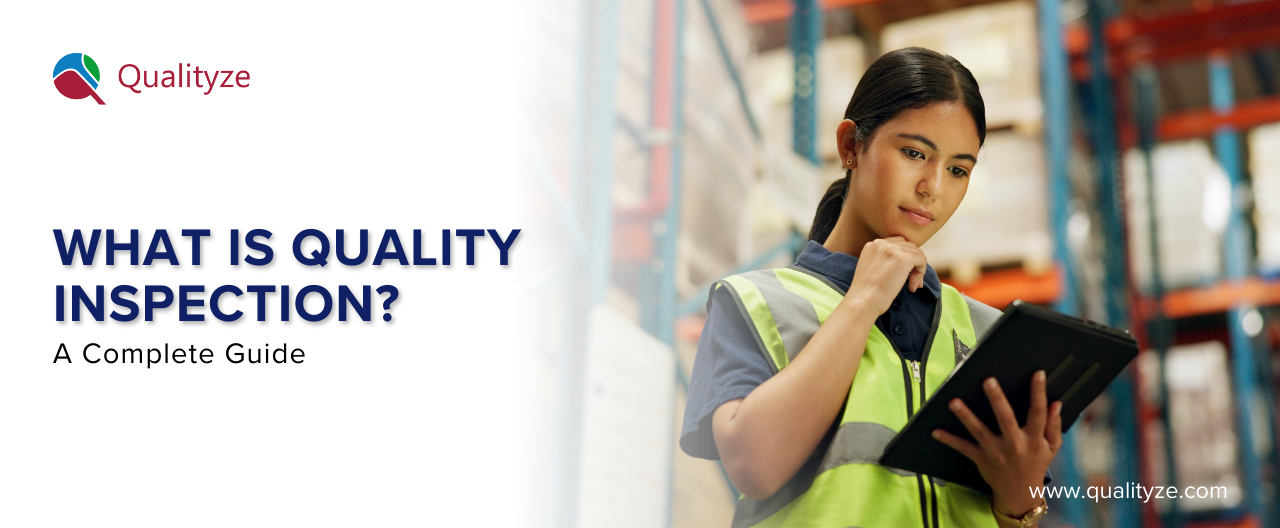1 What Is Quality Inspection?
Objectives of a quality inspection process
Core elements of an inspection checklist
4 Why Is Quality Inspection Important?
5 Types of Quality Inspection
Incoming Inspection
In-Process Inspection
Final Inspection
Specialized Inspections
10 Importance of Quality Inspection in Manufacturing
11 How Does Quality Inspection Connect QMS and PLM
12 Why Quality and Safety Leaders Need to Automate Inspection Management
Challenges of manual inspection
Advantages of Automated Inspection Management
15 How Qualityze Simplifies and Strengthens Quality Inspections for Modern Businesses

Quality inspection sits at the heart of any robust manufacturing or service operation. By systematically examining products, components, or processes against defined standards, quality inspection ensures that every deliverable meets customer expectations, regulatory requirements, and internal benchmarks. As W. Edwards Deming famously said, “Quality should be built in, not inspected in.” This guide will walk you through everything you need to know—definitions, importance, types, integration with QMS and PLM, the case for automation, and how Qualityze can transform your inspection program.
Definition of quality inspection
Quality inspection is the process of measuring, examining, and testing products, parts, or processes against specific requirements or standards. Unlike quality assurance (a preventive set of activities) or quality control (the broader framework that includes inspection, testing, and corrective actions), inspection focuses on hands-on verification activities—visual checks, dimensional measurements, functional tests, and more.
A well-structured inspection checklist drives consistency, minimizes human error, and forms the backbone of any inspection management system.
Reducing defects and costs
Poor quality hits the bottom line hard. According to the American Society for Quality (ASQ), the Cost of Poor Quality (COPQ) can range from 10% to 20% of a company’s annual revenue—that’s up to $20 million wasted each year on a $100 million business.
Protecting brand reputation and compliance
A single recall can erode customer trust overnight. Over 65% of manufacturers still rely on manual inspection methods—and 40% of these face frequent product recalls as a result. Robust inspection processes don’t just catch defects; they safeguard your reputation and ensure regulatory compliance.
“Quality is everyone’s responsibility.”
— W. Edwards Deming
Driving continuous improvement
Inspection data feeds root-cause analyses, enabling teams to tackle systemic issues rather than band-aid fixes. Over time, this data-driven approach reduces scrap, rework, and warranty claims—turning inspection from a cost center into a competitive advantage.
Understanding the types of quality inspection helps you deploy the right checks at the right time:
Incoming Inspection, or Incoming Quality Control (IQC), verifies that supplier provided raw materials, components, parts meet predefined specifications before they enter the production process. Technicians inspect material certificates, measure critical dimensions with calipers or micrometers, and perform material tests—such as hardness checks on metal billets or moisture analysis in plastic resins. For example, an aerospace manufacturer might use a handheld spectrometer to confirm the alloy composition of aluminum extrusions upon delivery. By catching deviations at the dock door, IQC prevents substandard inputs from cascading into costly production disruptions.
In-Process Inspection takes place at key stages within the manufacturing workflow, either continuously on-line or periodically off-line. On-line inspection integrates sensors and gauges directly into equipment—such as laser micrometers measuring pipe diameters in real time—while off-line inspection uses statistical sampling plans to examine selected batches in a quality lab. In a pharmaceutical tablet line, for instance, in-process checks include weight variation sampling and tablet hardness tests at every production shift. This balanced approach ensures critical parameters remain within control limits without inspecting every single unit.
Final Inspection serves as the last quality gate before products ship to customers. Inspectors conduct comprehensive audits against release criteria—visual appearance, functional performance, and packaging integrity. In the electronics industry, final inspection may include operating each device through power-up routines, verifying firmware versions, and confirming label accuracy. A medical device manufacturer, for instance, will perform leak tests on assembled infusion pumps and validate alarm functionality. Final Inspection safeguards brand reputation by ensuring only compliant, fully tested products reach the market.
Specialized Inspections employ advanced testing and automation techniques tailored to specific applications:
By orchestrating Incoming, In-Process, Final, and Specialized Inspections into a unified strategy, organizations secure end-to-end quality coverage—detecting issues at their origin and preventing defects from reaching downstream stages.
Manufacturing environments are complex ecosystems where a single defect can ripple across the supply chain. Here’s why quality inspection in manufacturing is non-negotiable:
Integral to Quality Control (QC)
Regulatory and Industry Standards
Operational and Financial Impact
By embedding inspection into manufacturing workflows—rather than treating it as a post-mortem check—organizations gain visibility, traceability, and control over product quality.
Linking Quality Management System (QMS) with Product Lifecycle Management (PLM) unlocks transformative insights:
Integration benefit:
When inspection data flows bidirectionally between QMS and PLM, companies achieve faster design-for-manufacturability cycles, fewer product iterations, and more confident regulatory submissions.
Key search terms to weave in: QMS PLM integration, product lifecycle quality, inspection feedback loop.
Manual inspection workflows—paper checklists, spreadsheets, slow data entry—are a recipe for errors and delays. Here’s why inspection management software is now table stakes:
For quality and safety leaders, automation means shifting from reactive firefighting to proactive risk management—spotting patterns before failures escalate.
Qualityze Inspection Management delivers an end-to-end, cloud-native solution that embeds best practices into every inspection. Here’s how it helps you win at quality:
Key Features
AI-Driven Insights
Qualityze AI engine analyzes historical inspection data to:
Seamless EQMS Integration
Inspection findings automatically link to other Qualityze modules:
Would you like to experience Qualityze difference to transform the inspection processes?
If manual inspections are slowing you down, or if you’re chasing data across spreadsheets and file cabinets, it’s time for a change. Qualityze Inspection Management empowers quality and safety leaders to automate, analyze, and act—transforming inspection from a burdensome chore into a strategic advantage.
Request a demo today and discover how Qualityze can simplify your inspection workflows, strengthen compliance, and drive continuous improvement—so you can deliver excellence, every time.